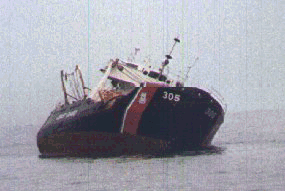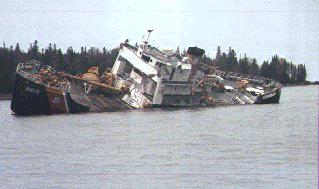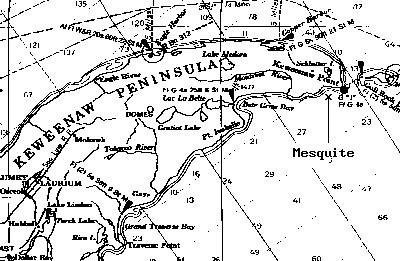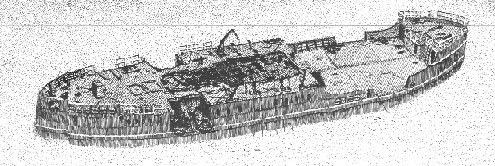



Vessel Type: Steel Coast Guard Cutter Size: 180 ft.x 37 ft. x 14 ft., 1028 gt. Wreck Date: December 4, 1989 Depth: 110ft. LON/LAT: 47. 23' 44 / 87. 44' 53 LORAN: 31715.4/46713.1
The Mesquite was filling in for her sister ship Sundew, attempting to finish up the late season job of collecting navigational markers when she was lost. While the Captain was below deck, a series of navigational errors allowed the Mesquite to drift too close to a reef. The rough December weather did the rest, firmly lodging the Mesquite on a rock ledge. The weather quickly worsened and the waves began to pound the Mesquite against the shoal. The crew may have been able to back her off by flooding the aft ballast tanks, but a general state of confusion onboard prevented an effective plan of action. After several hours, it became clear that the Mesquite's hull was badly damaged, as she was admitting water into the ships cabins. A distress call was put out and the crew was removed by a passing freighter.

Initially thought to be salvageable, a series of fierce storms battered the Mesquite and crusted her with a thick layer of ice. The unremitting weather caused the Mesquite to spend the winter on the reef. By Spring she was so badly damaged that salvage was out of the question. She was the first Coast Guard vessel ever to be declared a casualty. Rather than cut her up for scrap, she was removed from the reef in July of 1990 and sunk to the bottom in 110ft. of water as the centerpiece of the new Keweenaw Underwater Preserve. The Mesquite had been launched November 14, 1942 at Duluth, Minnesota and was built by the Marine Iron and Shipbuilding Company. She saw action in WWII and had served on the ocean as well as the Lakes.
The Mesquite now rests upright on the bottom just South of Keweenaw Point in Keystone Bay. She is a popular divesite and is easily penetrable. Her hull remains totally intact, but her superstructure was removed and most of her equipment was salvaged. Unfortunately, divers have plundered many of the articles which were left on her. The site is usually bouyed in the Summer months. Visibility at this site is excellent with the usual being 40 to 60 ft. Be prepared for bottom temperatures around 40 degrees.
The weather on the Keweenaw is quite fickle and the lake is often rough at the Point, so be sure to take a seaworthy boat. The Mesquite is best reached by putting in at Lac La Belle marina and taking the 1 hour trip to the site. A local dive charter service is also available.
 The Mesquite as she now
appears
The Mesquite as she now
appears
References: Wreck of the Mesquite by Frederick Stonehouse, Julius F. Wolff Jr.'s Lake Superior Shipwrecks, Jim and Pam Grill: Photos, Old World Chart Shop: Map of the Keweenaw Underwater Preserve.
Return to Keweenaw Menu